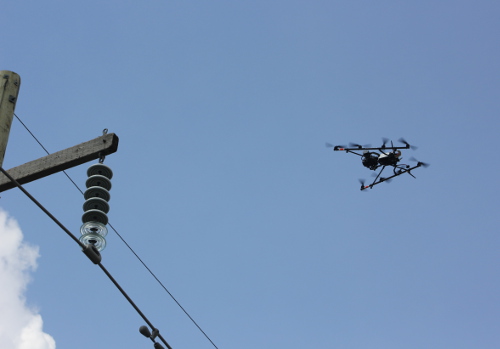
“Drones” have a mixed reputation these days. The public is working to sort out drones that bomb terrorists, those that can deliver retail purchases, those that threaten airline safety, those that spy, and those that provide a whole new kind of wedding photo. Recent field research on electric power industry applications of drones may add to the growing list of drone jobs that the public can embrace enthusiastically.
The U.S. Federal Aviation Administration prefers a more technical moniker: unmanned aircraft systems, or UAS. Last summer, EPRI researchers and UAS vendors gathered in Toronto to evaluate their potential to improve the speed, safety, and accuracy of one of the utility industry’s most dangerous tasks: inspecting transmission towers.
Passing a Towering Test in Toronto
At a Hydro One Networks facility, vendors piloted six drones around five de-energized transmission towers intentionally modified with defects, such as missing bolts, loose cotter pins, and chipped insulators. The payloads were high-resolution cameras and high-definition video to capture and transmit images to operators on the ground. Weighing between 10 and 60 pounds and measuring between 24 and 60 inches in diameter, the drones were able to maneuver closely and precisely around the transmission equipment.
Each test team included a pilot and a transmission line inspector to observe the device’s line of sight on a laptop monitor wirelessly linked to the onboard camera. The inspector directed the pilot—go left, hover, go right—as the drone-mounted gear inspected the 100-foot towers, capturing defects on still images and video. The outcome is promising: Using the quadcopters, hexacopters, and octocopters, the teams successfully navigated and inspected the towers, locating and recording images of all the flaws.
“The evaluations showed how we can use these systems to reduce the cost and risks of transmission line inspections while increasing their accuracy,” said EPRI Senior Program Manager Fabio Bologna, who supervised the tests.
The tests also led to insights for using other sensors such as infrared and ultraviolet cameras. Researchers determined that cameras with a minimum of 16 megapixels are needed for useable images. Some drones can carry only one camera, but certain inspections may require two or three cameras. While the aircraft are relatively light, the ground control stations often are not. “The stations ranged tremendously, from very small to so heavy that you needed two people to lug it around,” said Bologna.
Traditionally, teams of utility line inspectors climb tall towers or get hoisted on bucket trucks, which is time-consuming and potentially dangerous. The U.S. Bureau of Labor Statistics ranks power line installers and repairers as the ninth riskiest job in the country. “If you climb a structure and do a very detailed inspection, you won’t get very many done in a day,” said Bologna.
Other common methods include inspecting towers with binoculars from the ground 100 feet or more below or from inside a helicopter, which must maneuver at least 50 feet from electrified 345-kilovolt towers. Drones can fly much closer to the towers, providing a clearer picture of damage.
“An inspector in a helicopter may not be able to see everything at all the angles, like underneath and behind components,” said Bologna.
EPRI initially tested unmanned aerial systems for transmission line inspection in the late 1990s, but their imaging capabilities and cost made them unfeasible. Today’s systems cost less and are much lighter and more maneuverable. Some models can use autopilot capabilities to fly predetermined inspection paths around structures.
High-Voltage Testing
Beginning this year, researchers will evaluate drones as they inspect energized power lines in New York State. The tests will look at the effects of arcing, sparking, and electric and magnetic fields on the aircraft’s operation and help determine safe flying distances from energized lines. Researchers will also evaluate the effectiveness of infrared and ultraviolet cameras and other sensors, including how close and how stable they must be to provide a clear picture.
In the near future, Bologna expects that work now done by tower-climbing linemen will be done more safely and more precisely with drone-mounted equipment. “This is going to change a lot of things for the power industry,” he said. It may also help the public see drones as “the guys in the white hats.”
EPRI Technical Expert:
Fabio Bologna
Watch a video about the field tests.
Further resources:
One thought on “Unmanned Aircraft Systems Pass Field Tests with Flying Colors”
Comments are closed.



In the near future Drones for sure are going to be used extensively for carrying out inspection of Transmission lines. Coupled with a LiDAR camera the Drones can also be used to carryout the survey (for route alignment) for a new transmission line. The use of Drones provides savings in time and money without compromising on the quality of the data. A Software can be used for efficient “data analysis” to produce a Report for the user.
It would therefore be in the larger interest that EPRI recommends the technical parameters in respect of the Drones, cameras and the features of the software for carrying out both the survey and inspection of a energized transmission line.